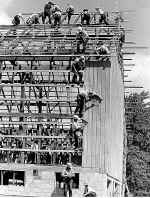Service
Many Mennonite churches continue to emphasize service as an important aspect of church life. Often this has been seen as the way "the rubber hits the road" in what it means to be a community. The idea of helping those who are having trouble within the church has been an important part of this tradition, and has also pushed Mennonites to look beyond the limits of their churches in order to help others.
Within the Mennonite Community
| Raising the structure |
Support within the Mennonite community is often referred to as mutual aid. The repeated migrations of Mennonite people provides one example of this value at work. Dutch Mennonites helped to finance early Swiss migrations to North America. Large migrations from Russia were made possible through the help of other Mennonite groups already living in Canada. Although in some cases aid was given to relatives and friends, many times there was no personal connection.
Barn-raisings, still practiced by members of the Old Order Amish and Old Order Mennonite communities, provide perhaps the most vivid examples of this commitment to helping one another. Due to their religious beliefs, many of these groups do not buy insurance; rather, they rely on others within their religious community to help people through rough times. When a barn is destroyed by fire or damaged by a storm, the community descends on the farm with their materials and tools. As many as 250 men proceed to build a barn from the ground up to replace the old one - sometimes all in 1 day!
For other Mennonite groups, financial institutions such as Mennonite Credit Unions, rotating funds, and more informal arrangements are other ways in which Mennonites from many different backgrounds and areas have been able to help one another.
Service Outside of the Church
This tradition of helping others in need, often simply referred to as service, has also extended beyond Mennonites themselves. Mennonite Central Committee (MCC), originally organized to bring supplies to Russia after the revolution in 1917, continues to seek international development. It is involved in everything from digging wells for clean drinking water to teaching nutrition and other projects. In one project MCC started a "Food Bank" for grain to be sent overseas. In the span of one year in 1987-1988 this project shipped over 84,000 metric tons of grain to other countries, worth about $25 million; about one-third of the grain came from Mennonites.
Mennonite Disaster Service (MDS) sends workers to clean up and help rebuild after floods, hurricanes, tornadoes, and other disasters strike. Mennonite Economic Development Agency encourages and makes money available to people starting small businesses in the developing world; Ten Thousand Villages supports artisans overseas by paying fair prices for their products, which are then imported to North America and sold to provide seed money for other projects. The list of organizations and agencies goes on and on.
Mennonite congregations have also sponsored refugees and immigrants to come from other countries. Often these newcomers have also become part of the Mennonite church. Some have started congregations in their native language, where they worship and seek to attract others of their cultural background.
Created 1998 by Derek Suderman
